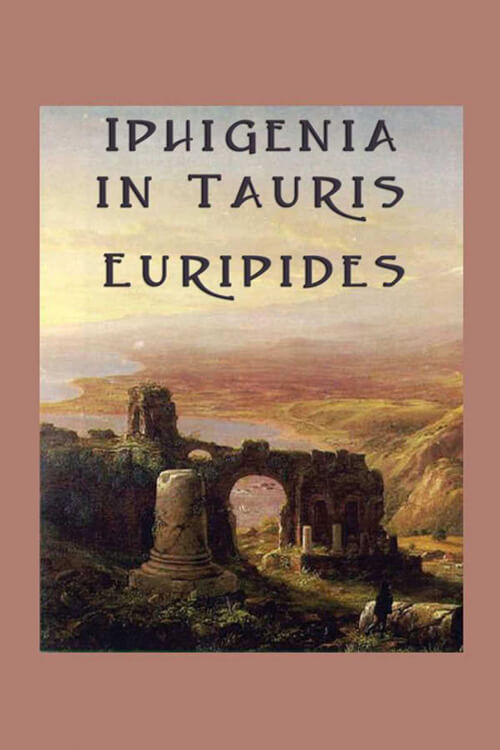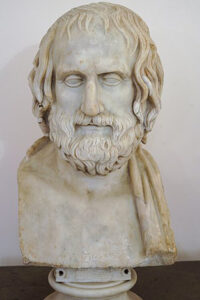
The Iphigenia in Tauris
The Iphigenia in Tauris is not, in the modern sense, a tragedy; it is a romantic play, beginning in a tragic atmosphere and moving through perils and escapes to a happy end. To the archaeologist, the cause of this lies in the ritual on which the play is based. All Greek tragedies that we know have as their nucleus something that the Greeks called an Aition—a cause or origin. They all explain some ritual or observance or commemorate some great event. Nearly all have for this Aition a Tomb Ritual, as, for instance, the Hippolytus has the worship paid by the Trozenian Maidens at that hero’s grave. The use of this Tomb Ritual may well explain both the intense shadow of death that normally hangs over the Greek tragedies, and also perhaps the feeling of the Fatality, which is, rightly or wrongly, supposed to be prominent in them. For if you are engaged in commemorating your hero’s funeral, it follows that all through the story, however bright his prospects may seem, you feel that he is bound to die; he cannot escape. A good many tragedies, however, are built not on Tomb Rituals but on other sacred Aitia: on the foundation of a city, like the Aetnae, the ritual of the torch-race, like the Prometheus; on some great legendary succoring of the oppressed, like the Suppliant Women of Aeschylus and Euripides. The rite on which the Iphigenia is based is essentially one in which a man is brought to the verge of death but just does not die.
The rite is explained in 11. 1450 ff. of the play. On a certain festival at Halae in Attica a human victim was led to the altar of Artemis Tauropolos, touched on the throat with a sword, and then set free: very much what happened to Orestes among the Tauri, and exactly what happened to Iphigenia at Aulis. Both legends have doubtless grown out of the same ritual.
Like all the great Greek legends, the Iphigenia myths take many varying forms. They are all of them, in their essence, conjectural restorations, by poets or other ‘wise men,’ of supposed early history. According to the present play, Agamemnon, when just about to sail with all the powers of Greece against Troy, was bound by weather at Aulis. The medicine man Calchas explained that Artemis demanded the sacrifice of his daughter, Iphigenia, who was then at home with her mother, Clytemnestra. Odysseus and Agamemnon sent for the maiden on the pretext that she was to be married to the famous young hero, Achilles; she was brought to Aulis and treacherously slaughtered—or, at least, so people thought.
Read or download Book
Euripedes
Euripides (c. 480 – c. 406 BC) was a tragedian of classical Athens. Along with Aeschylus and Sophocles, he is one of the three ancient Greek tragedians for whom any plays have survived in full. Some ancient scholars attributed ninety-five plays to him, but the Suda says it was ninety-two at most. Of these, eighteen or nineteen have survived more or less complete (Rhesus is suspect). There are many fragments (some substantial) of most of his other plays. More of his plays have survived intact than those of Aeschylus and Sophocles together, partly because his popularity grew as theirs declined—he became, in the Hellenistic Age, a cornerstone of ancient literary education, along with Homer, Demosthenes, and Menander.
Euripides is identified with theatrical innovations that have profoundly influenced drama down to modern times, especially in the representation of traditional, mythical heroes as ordinary people in extraordinary circumstances. This new approach led him to pioneer developments that later writers adapted to comedy, some of which are characteristic of romance. He also became “the most tragic of poets”, focusing on the inner lives and motives of his characters in a way previously unknown. He was “the creator of … that cage which is the theatre of Shakespeare’s Othello, Racine’s Phèdre, of Ibsen and Strindberg,” in which “imprisoned men and women destroy each other by the intensity of their loves and hates”. But he was also the literary ancestor of comic dramatists as diverse as Menander and George Bernard Shaw.
His contemporaries associated him with Socrates as a leader of decadent intellectualism. Both were frequently lampooned by comic poets such as Aristophanes. Socrates was eventually put on trial and executed as a corrupting influence. Ancient biographies hold that Euripides chose a voluntary exile in old age, dying in Macedonia, but recent scholarship casts doubt on these sources.
Life
Traditional accounts of the author’s life are found in many commentaries, and include details such as these: He was born on Salamis Island around 480 BC, with parents Cleito (mother) and Mnesarchus (father), a retailer from the deme of Phlya. On receiving an oracle that his son was fated to win “crowns of victory”, Mnesarchus insisted that the boy should train for a career in athletics. But the boy was destined for a career on the stage (where he was to win only five victories, one of these posthumously). He served for a short time as both dancer and torch-bearer at the rites of Apollo Zosterius. His education was not confined to athletics, studying also painting and philosophy under the masters Prodicus and Anaxagoras. He had two disastrous marriages, and both his wives—Melite and Choerine (the latter bearing him three sons)—were unfaithful. He became a recluse, making a home for himself in a cave on Salamis (the Cave of Euripides, where a cult of the playwright developed after his death). “There he built an impressive library and pursued daily communion with the sea and sky”. The details of his death are uncertain. It was traditionally held that he retired to the “rustic court” of King Archelaus in Macedonia, where he died in 406 BC, but modern scholarship is skeptical of these claims. It is possible that in reality he never visited Macedonia at all, or if he did, he might have been drawn there by King Archelaus with incentives that were also offered to other artists.






